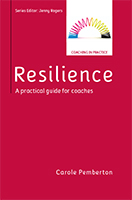Recently I sat in a presentation by a major supermarket. The audience of business leaders listened with sceptical curiosity as the speaker claimed resilience as a core organisational skill, and explained how they had introduced resilience training to thousands of employees, many of whom work at checkouts .
The question of ROI hung in the air. For some it was business ROI – how could they justify the cost of a large scale programme at a time of financial difficulty? As a coach and trainer the ROI I was interested in was whether a 2 hour session on mindfulness could make any difference to an employee’s ability to work with uncertainty and pressure. Can resilience training make a difference?
This question is addressed in a timely new study by Ivan Robertson and colleagues, reported in the June 2015 issue of the Journal of Occupational and Organisational Psychology. The Robertson Cooper i- resilience questionnaire is widely used as a diagnostic of resilience capacity. The follow on from diagnosis is how best to address identified needs. Do some approaches work better than others? Does the length of intervention make a difference? What is most likely to be impacted by a formal training programme?
The study is important because it is the first to systematically look at the 155 English language studies on resilience training published in peer reviewed academic journals since 2003. After applying rigorous criteria to filter the studies, it concluded that only 14 were robust enough to allow for examining the validity of their outcomes.
The 14 studies included programmes varying in length from single 90 minute sessions to workshops run over 12 weeks; From on line programmes to 2.5 day retreats and group workshops supported with 1:1 coaching. While positive psychology and CBT have been the most commonly used approaches written about in the professional resilience literature, their study also included programmes built around mindfulness, Acceptance and Commitment Therapy and the stress reduction brain training model Attention and Interpretation Therapy. One programme even used technology in the form of emWave biofeedback machines to help participants self manage their own stress. So with such diversity of approaches, what conclusions did they reach as to the value of resilience training?
The Evidence
The research concluded that resilience training may have benefits for subjective well being outcomes such as stress, anxiety, depression and negative thoughts and emotional responses, but the evidence is not yet robust enough to make claims with certainty, because sample sizes are so small that claims of significant shift are difficult to defend.
Several studies did, however, show a significant positive effect on self efficacy i.e. the participants confidence in their ability to take action was increased as a result of the input. Another study showed a significant reduction in participants’ fatigue after resilience training.
A study which measured biological outcomes reported a significant increase in participant antithrombin levels after training. Antithrombin is an anti-coagulant which helps prevent thrombosis. It also reported a reduction in the stress hormone cortisol amongst those who completed the programme. So resilience training can work at a physiological level.
Most programmes included a cognitive behavioural approach to developing resilience but they concluded that there is no strong evidence on what makes for the most effective training content or format, or that there is an optimal programme length.
Implications
Inevitably, since this was an academic review it highlighted the weaknesses in the methodologies of existing research and therefore the danger of drawing firm conclusions. However, it offers some hints as to what works when designing resilience programmes.
- The organisation needs to be clear as to what they mean by resilience, and to design interventions that build from that definition. There are many academic definitions, so it is important to understand what the particular context means by resilience and why it is important to them.
- If the organisation wants to assess ROI, it makes sense to uses a resilience questionnaire designed for work rather than clinical settings at the outset, and to do a retest after the completion of the training.
- While there appears to be no one best way of developing resilience through training, there is evidence that some element of 1:1 coaching and/or on going support is advisable.
What this work highlights is that while resilience is a word frequently claimed by organisations as a requirement for success, and by individuals as a capacity they wish to develop, finding an effective way do so in organisational settings is still in its infancy. It also encourages coaches and programme designers to focus on the need of participants within their particular setting and to build the programme with the end in mind. It also highlights that just as resilience is aided by the availability of support, resilience training is aided when there is room for 1:1 support alongside any group activity.
‘
Full details of the article ’Resilience training in the workplace from 2003 to 2014: a systematic review’ by Ivan Robertson, Cary Cooper, Mustafa Sarkar and Thomas Curran can be found at: http://onlinelibrary.wiley.com/doi/10.1111/joop.12120/abstrac










